1993 CHEVROLET S10 brakes
[x] Cancel search: brakesPage 70 of 356

Downloaded from www.Manualslib.com manuals search engine Features & Controls
I
e
OD (Automatic Overdrive). This position is for normal driving. If you need
more power for passing, and you’re:
- Going less than about 35 mph (56 km/h), push your accelerator
pedal about halfway down.
- Going about 35 mph (56 km/h) or more, push the accelerator all the
way down. You’ll shift down to the next gear and have more power.
OD should not be used when towing a trailer, carrying a heavy load,
driving on steep hills, or for off-road driving. Select
D (third gear) when
operating the vehicle under any of these conditions.
D (Third Gear). This is like OD, but you never go into Overdrive. You
should use
D when towing a trailer, carrying a heavy load, driving on
steeps hills, or for off-road driving.
2 (Second Gear). This position gives you more power but lower \
fuel
economy. You can use
2 (Second Gear) on hills. It can help control your
speed as you go down steep mountain roads, but then you would\
also
want to use your brakes off and on.
If you have a 4.3L engine (Codes Z and W) and if you manually select
2, the transmission will drive in second gear. You may use this feature
for reducing torque
to the rear wheels when you are trying to start your
vehicle from a stop on slippery road surfaces.
1 (First Gear). This position gives you even more power (but \
lower fuel
economy) than
2. You can use it on very steep hills, or in deep snow or
mud. If the selector lever is put in 1, the transmission won’t shift into
first gear until the vehicle is going slowly enough.
2-1 8
Page 93 of 356
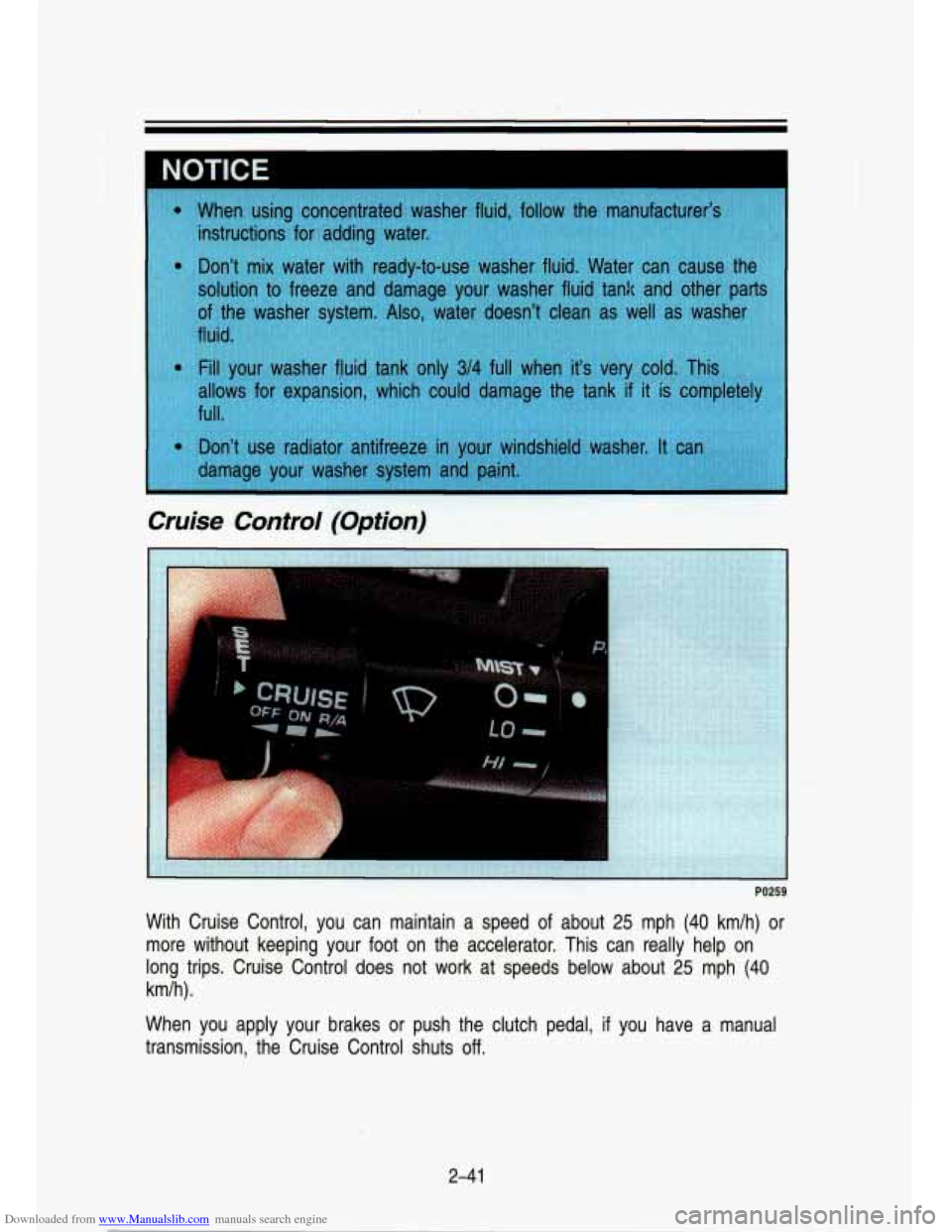
Downloaded from www.Manualslib.com manuals search engine I 1OTICE
Cruise Control (Option)
PO259
With Cruise Control, you can maintain a speed of about 25 mph (40 km/h) or
more without keeping your foot on the accelerator. This can re\
ally help on
long trips. Cruise Control does not work at speeds below about\
25 mph (40
kmlh).
When you apply your brakes
or push the clutch pedal, if you have a manual
transmission, the Cruise Control shuts
off.
2-4 1
Page 118 of 356

Downloaded from www.Manualslib.com manuals search engine i
Features & Controls
Gages can indicate when there may be or is a problem with one of your
vehicle’s functions. Often gages and warning lights work toge\
ther
to let you
know when there’s a problem with your vehicle.
When one of the warning lights comes on and stays on when you are
driving, or when one of the gages shows there may be a probl\
em, check the
section that tells you what to do about
it. Please follow the manual’s advice.
Waiting to do repairs can be costly-and even dangerous.
So please get to
know your warning lights and gages. They’re a big help.
Brake System Warning Light
Standard Cluster Digital Cluster
Pol 59
Your vehicle’s hydraulic brake system is divided into two parts. If one part
isn’t working, the other part can still work and stop you. \
For good braking,
though, you need both parts working well. Your vehicle also ha\
s rear wheel anti-lock brakes. If the warning light goes on, there could be a brake problem
with either your regular or rear wheel anti-lock brakes, or both. Have you\
r
brake system inspected right away.
This light should come on as you start the vehicle. If it do\
esn’t come on
then, have it fixed
so it will be ready to warn you if there’s a problem.
This light will also come on when you set your parking brake, and will stay
on if your parking brake doesn’t release fully. If it stays on after your parking
brake is fully released,
it means you may have a brake problem. If the light
comes on while driving, pull
off the road and stop carefully. You may notice
that the pedal is harder
to push. Or, the pedal may go closer to the floor. It
may take longer to stop. If the light is still on, have the vehicle towed for
service. (See “Towing Your Vehicle” in the Index.)
2-66
I
Page 166 of 356
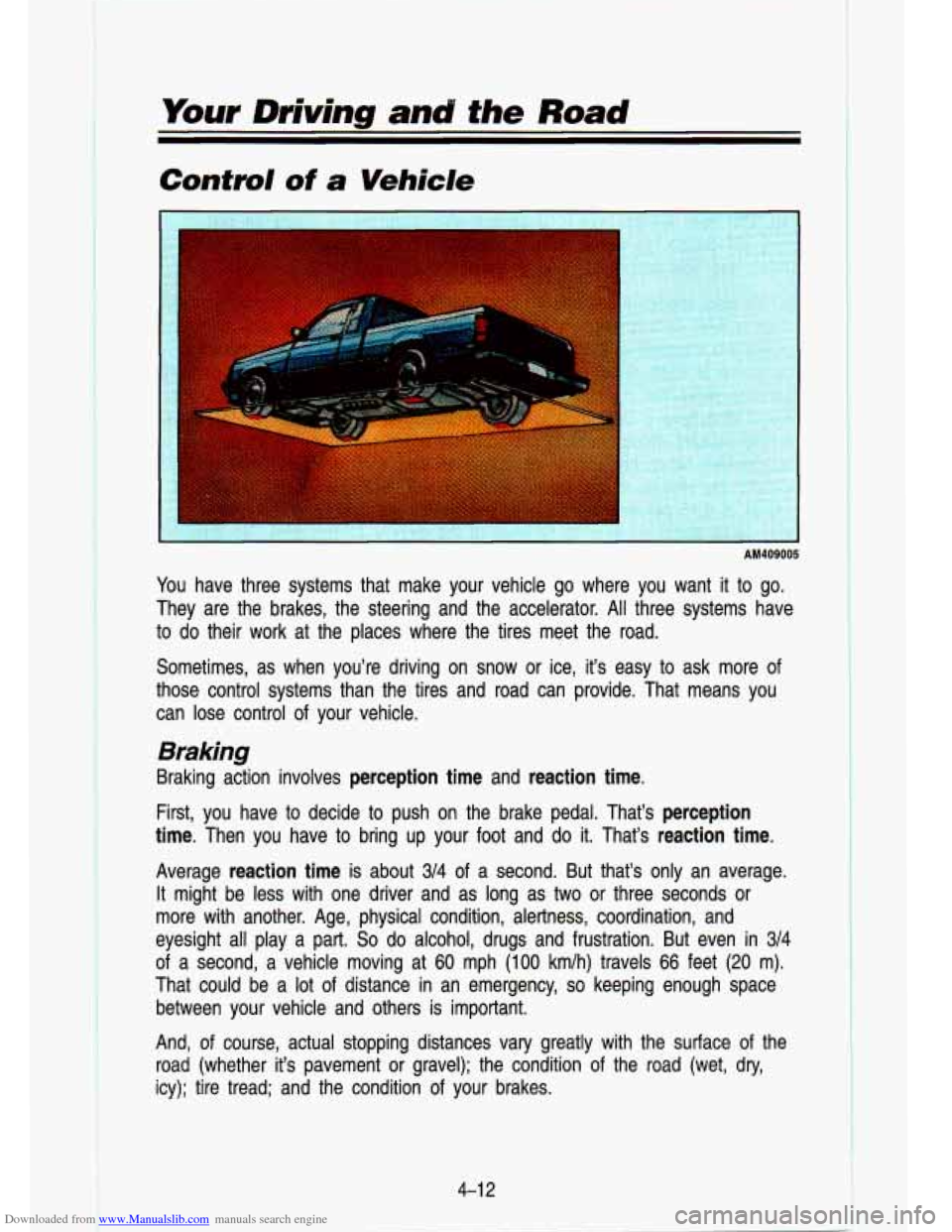
Downloaded from www.Manualslib.com manuals search engine Your Driving and the Road
Control of a Vehicle
AM409005
You have three systems that make your vehicle go where you want it to go.
They are the brakes, the steering and the accelerator. All thr\
ee systems have
to do their work at the places where the tires meet the road.
Sometimes, as when you’re driving on snow or ice, it’s e\
asy
to ask more of
those control systems than the tires and road can provide. Tha\
t means you
can lose control
of your vehicle.
Braking
Braking action involves perception time and reaction time.
First, you have
to decide to push on the brake pedal. That’s perception
time. Then you have to bring up your foot and do it. That’\
s reaction time.
Average reaction time is about
314 of a second. But that’s only an average.
It might be less with one driver and as long as two or three seconds or
more with another. Age, physical condition, alertness, coordinati\
on, and
eyesight all play a part.
So do alcohol, drugs and frustration. But even in 3/4
of a second, a vehicle moving at 60 mph (100 km/h) travels 66 feet (20 m).
That could be a
lot of distance in an emergency, so keeping enough space
between your vehicle and others is important.
And,
of course, actual stopping distances vary greatly with the surface of the
road (whether it’s pavement or gravel); the condition of t\
he road (wet,
dry,
icy); tire tread; and the condition of your brakes.
Page 167 of 356
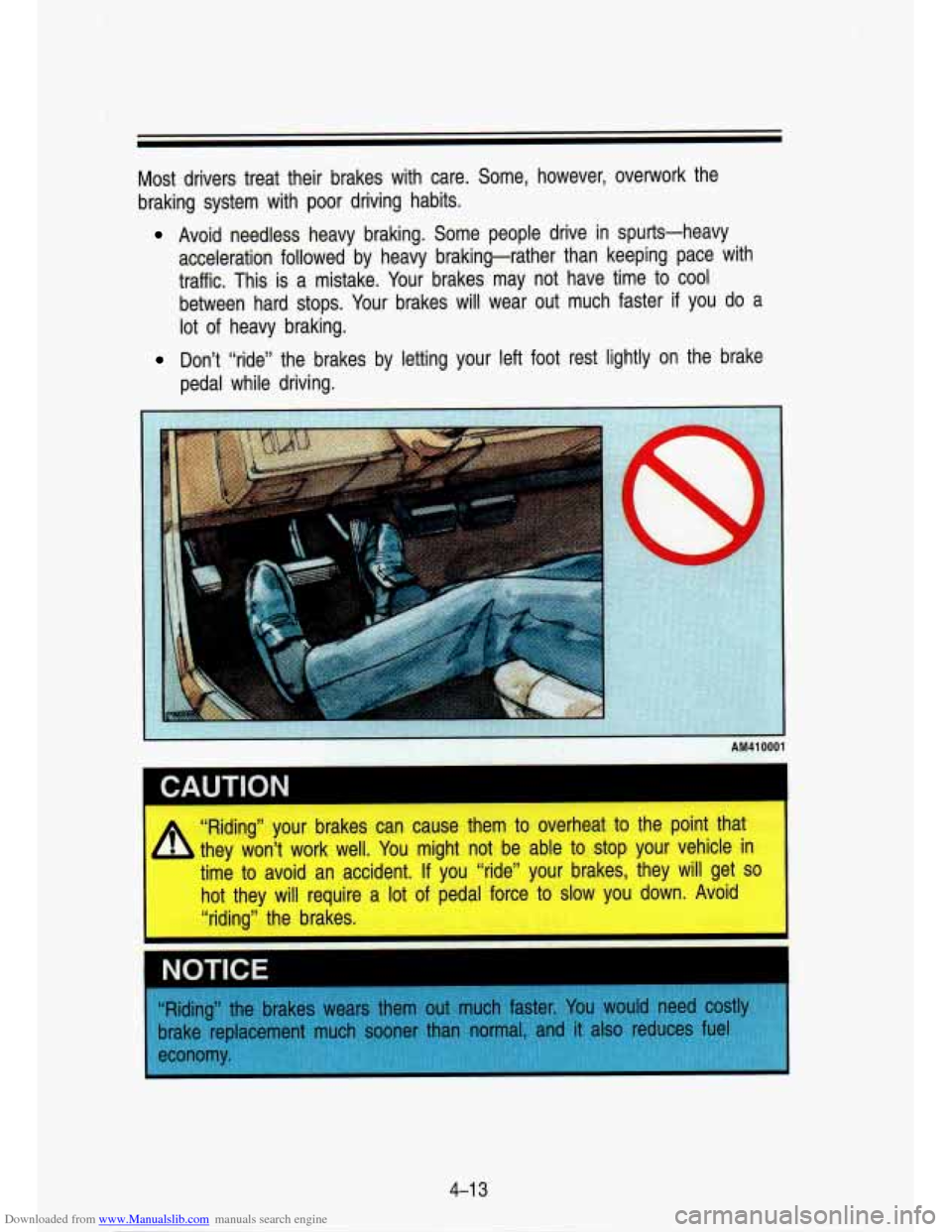
Downloaded from www.Manualslib.com manuals search engine Most drivers treat their brakes with care. Some, however, overw\
ork the
braking system with poor driving habits.
Avoid needless heavy braking. Some people drive in spurts-heavy
acceleration followed by heavy braking-rather than keeping pace with
traffic. This is a mistake. Your brakes may not have time
to cool
between hard stops. Your brakes will wear out much faster
if you do a
lot of heavy braking.
Don’t “ride” the brakes by letting your left foot rest lightly on the brake
pedal while driving.
I
“Riding” your brakes can cause them to overheat to the point that
they won’t work well. You might not be able to stop your vehicle in
time
to avoid an accident. If you “ride” your brakes, they will get so
hot they will require a lot of pedal force to slow you down. Avoid
“riding” the brakes.
NOTICE
4-1 3
-
Page 168 of 356
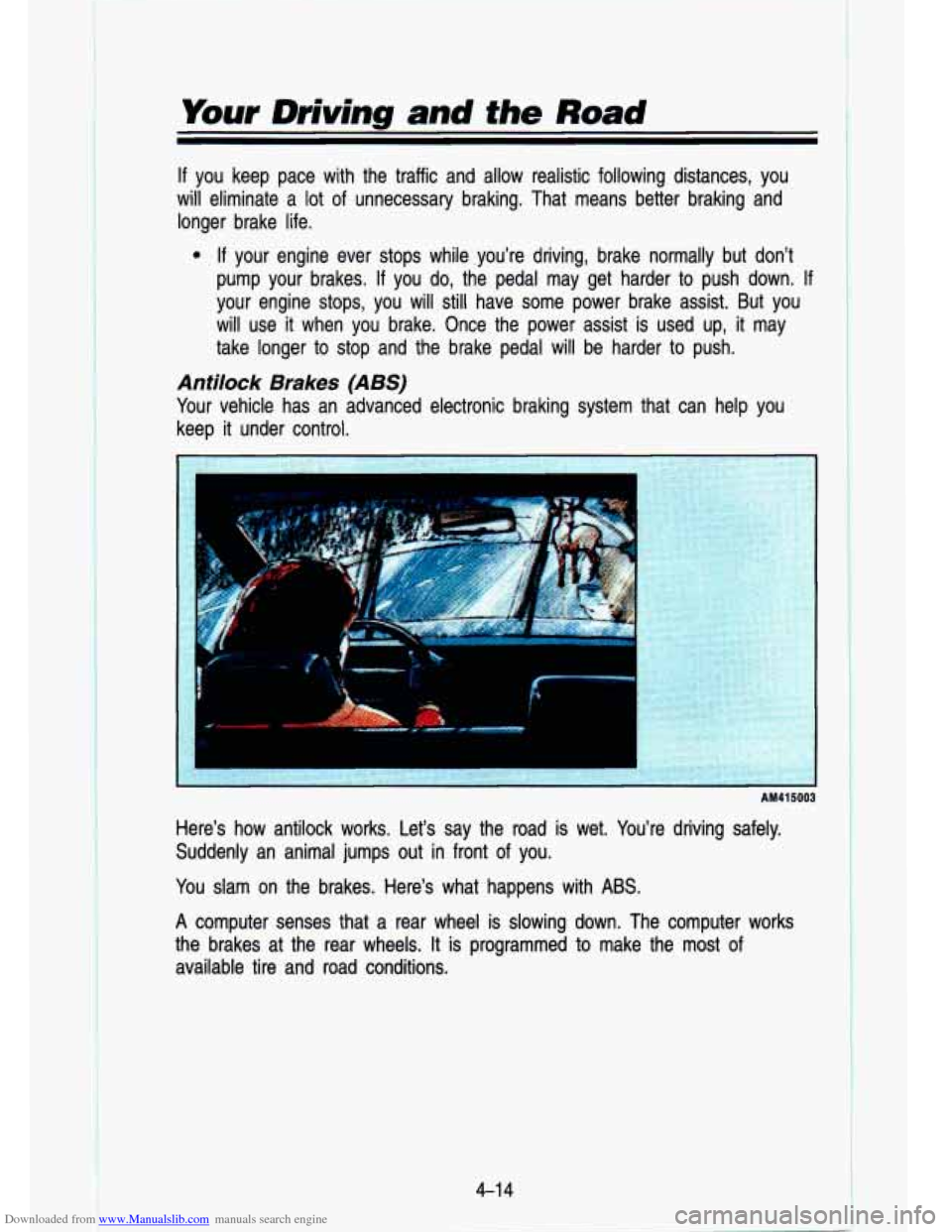
Downloaded from www.Manualslib.com manuals search engine Your Driving and the Road
If you keep pace with the traffic and allow realistic followin\
g distances, you
will eliminate a
lot of unnecessary braking. That means better braking and
longer brake life.
a If your engine ever stops while you’re driving, brake normally but don’t
pump your brakes. If you
do, the pedal may get harder to push down. If
your engine stops, you will still have some power brake assist\
. But you
will use
it when you brake. Once the power assist is used up, it may
take longer
to stop and the brake pedal will be harder to push.
E
Antilock Brakes (ABS)
Your vehicle has an advanced electronic braking sysrem that can help\
you
keep
it under control.
I
t AM415003
Here’s how antilock works. Let’s say the road is wet. You’re driving safely.
Suddenly an animal jumps out in front of you.
You slam on the brakes. Here’s what happens with
ABS.
A computer senses that a rear wheel is slowing down. The computer works
the brakes at the rear wheels.
It is programmed to make the most of
available tire and road conditions.
4-1 4
Page 169 of 356
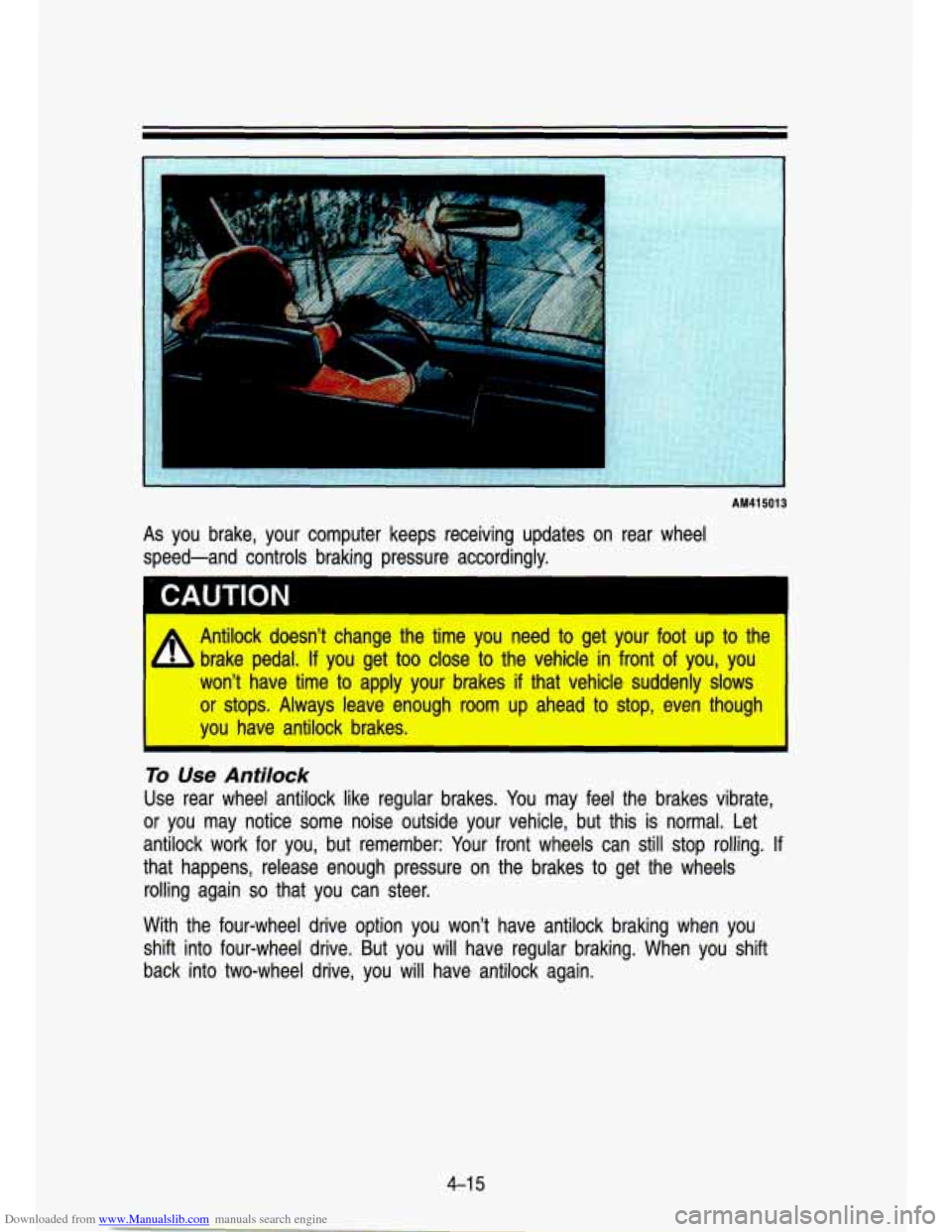
Downloaded from www.Manualslib.com manuals search engine 1
AM41 5013
As you brake, your computer keeps receiving updates on rear wheel
speed-and controls braking pressure accordingly.
Antilock doesn't change the time
you need to get your foot u8p to the
brake pedal.
If you get too clloise to the vehicle in front of you, you
won? have time to apply your brakes if that vehicle suddenly slows
or stops. Always leave enough room ulp ahead to stop, even thouglh
you have antilock brakes. I
To Use Antilock
Use rear wheel antilock like regular brakes. You may feel the brakes vibrate,
or you may notice some noise outside your vehicle, but this i\
s normal. Let antilock work for you, but remember: Your front wheels can still stop rolling. If
that happens, release enough pressure on the brakes to get the wheels
rolling again
so that you can steer.
With the four-wheel drive option you won't have antilock brakin\
g when you
shift into four-wheel drive. But you will have regular braking.\
When you shift
back into two-wheel drive, you will have antilock again.
4-1 5
Page 170 of 356
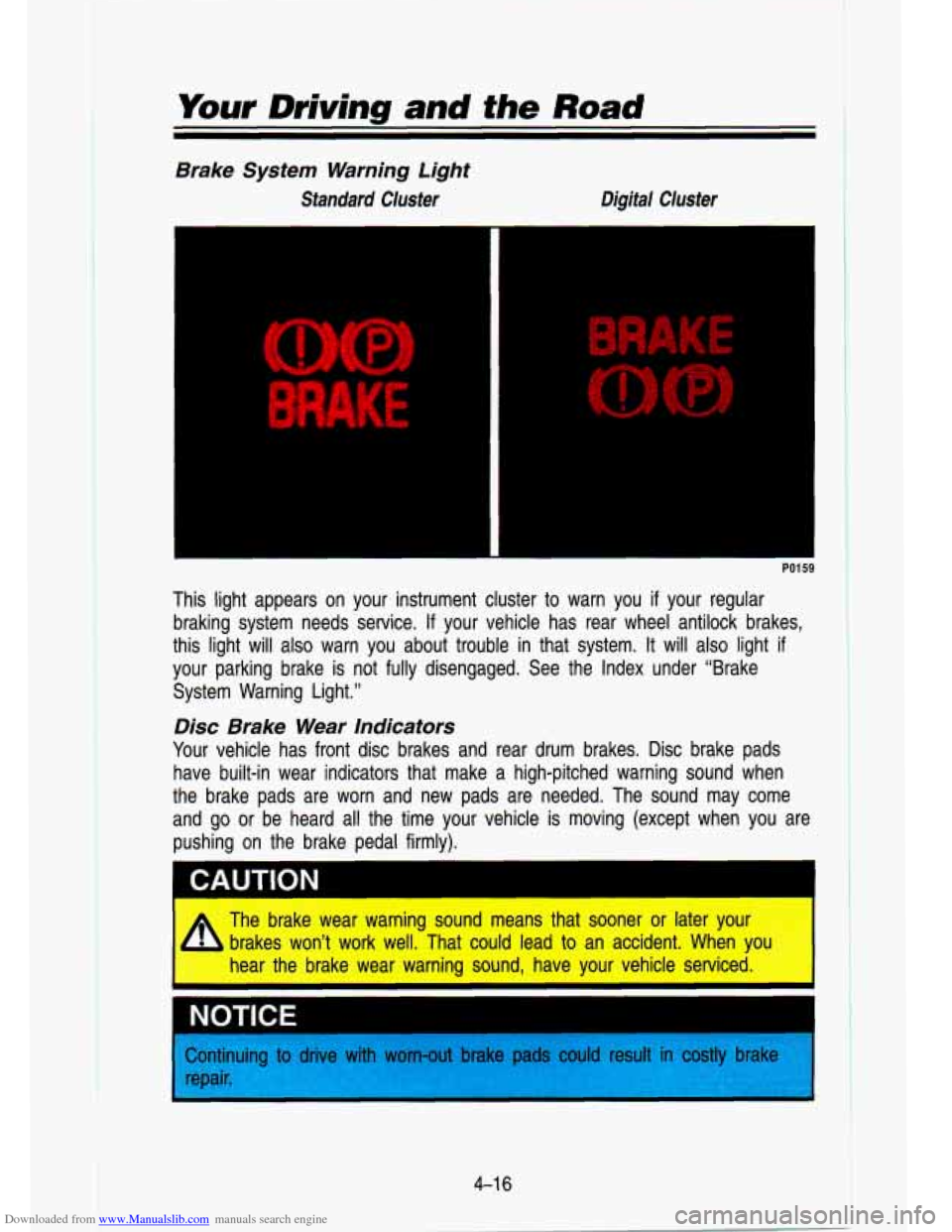
Downloaded from www.Manualslib.com manuals search engine Your Driving and the Road
Brake System Warning Light
Standard Cluster
Digital Cluster
This light appears on your instrument cluster to warn you if your regular
braking system needs service.
If your vehicle has rear wheel antilock brakes,
this light will
also warn you about trouble in that system. It will also light if
your parking brake is not fully disengaged. See the Index unde\
r “Brake
System Warning Light.”
Disc Brake Wear Indicators
Your vehicle has front disc brakes and rear drum brakes. Disc brake pads
have built-in wear indicators that make a high-pitched warning \
sound when
the brake pads are worn and new pads are needed. The sound m\
ay come
and go or be heard all the time your vehicle is moving (except \
when you are
pushing on the brake pedal firmly).
The brake wear warning sound means that sooner or later your brakes won’t work well. That could lead to an accident. When yo
hear the brake wear warning sound, have your vehicle serviced. \
I NOTICE
>ontinuing ti
epair.
e with worn-out bra1 could sult in lstly brake